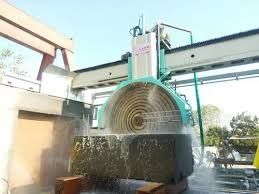Stone cutting technology has transformed traditional craftsmanship into a high-precision industrial process. From shaping marble and granite for architecture to fabricating customized stone panels, modern stone cutting machines combine mechanical accuracy with automation.
This guide explores the types, components, and applications of stone cutting systems — including CNC machines, bridge saws, and waterjet cutters — and how they support industries such as construction, interiors, and manufacturing.
Understanding Stone Cutting Machines
A stone cutting machine is a specialized tool designed to cut, shape, and polish natural and engineered stones with precision. These machines use blades, abrasives, or waterjet technology to achieve accurate and smooth finishes across various stone types such as granite, marble, sandstone, and quartz.
Industrial stone cutting systems are used for:
-
Architectural stone fabrication
-
Countertops and flooring production
-
Monuments and sculptures
-
Industrial component manufacturing
Key Types of Stone Cutting Machines
1. CNC Stone Cutting Machine
CNC (Computer Numerical Control) machines bring automation to stone processing. Controlled through programmed software, these machines perform precise cutting, engraving, and polishing operations.
Key Features:
-
Automated control for high accuracy
-
Suitable for complex designs and patterns
-
Multi-axis motion for 3D cutting
-
Reduced material waste and manual errors
Common Applications:
-
Decorative panels and engraved designs
-
Marble inlays for interiors
-
Precision stone molds
2. Granite Cutting Machine
Granite, one of the hardest natural stones, requires robust and high-power machinery for effective cutting.
Highlights:
-
Heavy-duty diamond blades
-
Adjustable cutting depth
-
Water-cooling systems to reduce friction
-
Used in slabs, tiles, and monument production
Granite cutting machines are integral to construction and architectural projects demanding durability and precision.
3. Marble Cutting Machine
Marble is widely used in flooring, sculpture, and interior decor. Marble cutting machines are designed to deliver clean cuts and smooth surfaces without chipping.
Features:
-
Precision-guided saw blades
-
Variable speed settings
-
Integrated dust and water control
-
Fine finishing for artistic detailing
These machines support both architectural and aesthetic applications across industries.
4. Bridge Saw Stone Cutter
A bridge saw features a motorized saw blade mounted on a movable bridge structure, allowing consistent straight-line cutting.
Advantages:
-
Suitable for large stone slabs
-
High structural stability
-
Precise angular and linear cuts
-
Programmable automation in modern models
Bridge saws are ideal for workshops that process heavy stone materials in standardized dimensions.
5. Waterjet Stone Cutting Machine
Waterjet cutting uses high-pressure water mixed with abrasive particles to slice through stone without generating heat.
Benefits:
-
No thermal damage or cracks
-
Cuts thick materials accurately
-
Works for granite, marble, and composite stones
-
Environmentally friendly process
Waterjet systems are especially valued in precision industries and architectural customization.
Industrial Stone Cutting Tools and Accessories
Supporting components and tools are crucial for maintaining efficiency in stone cutting operations:
| Tool/Component | Function |
|---|---|
| Diamond Saw Blades | For high-speed precision cutting |
| Water Pumps & Cooling Systems | Prevent overheating during operation |
| Abrasive Nozzles | Used in waterjet systems for sharp cutting edges |
| Clamping Systems | Secure stone slabs during cutting |
| Dust Collection Units | Maintain clean and safe work environments |
Technology and Automation in Modern Stone Cutting
Automation has revolutionized industrial stone fabrication. Key technological innovations include:
-
CAD/CAM Integration: Converts digital designs into precise cutting paths.
-
Laser Alignment Systems: Ensures exact cutting lines and minimal waste.
-
Smart Monitoring: Real-time performance analytics for maintenance prediction.
-
Energy Efficiency: Optimized motor and blade systems reduce power consumption.
These advances have improved productivity, precision, and sustainability in stone cutting operations.
Applications of Stone Cutting Machines
Stone cutting systems serve multiple industries beyond construction:
| Industry | Application Example |
|---|---|
| Architecture | Façade panels, flooring, columns |
| Interior Design | Kitchen countertops, bathroom surfaces |
| Sculpture & Art | Engraved marble and statues |
| Monument Manufacturing | Memorial stones, headstones |
| Industrial Manufacturing | Stone molds and precision stone components |
Installation and Maintenance Overview
To ensure long-term reliability, installation and maintenance should follow structured procedures:
Installation Steps:
-
Foundation preparation for stability
-
Alignment of the cutting bridge or CNC platform
-
Electrical and hydraulic system setup
-
Calibration of sensors and control software
-
Trial operation for precision validation
Maintenance Guidelines:
-
Regular lubrication and cleaning of moving parts
-
Inspection of cutting blades and nozzles
-
Monitoring coolant and water circulation systems
-
Periodic calibration of sensors and motors
Preventive maintenance minimizes downtime and ensures consistent cutting quality.
Safety Considerations in Stone Cutting
Safety is critical due to the high-speed machinery and dust involved.
-
Always use protective eyewear and gloves
-
Ensure proper ventilation and dust control
-
Follow manufacturer guidelines for pressure and blade speed
-
Maintain machine guards and emergency stops
-
Conduct regular operator safety training
Frequently Asked Questions
Q1. What is the difference between CNC and bridge saw stone cutters?
CNC machines are computer-controlled for complex designs, while bridge saws are ideal for linear, large-scale cuts.
Q2. Can waterjet machines cut all types of stones?
Yes, they can process almost any natural or engineered stone without causing thermal damage.
Q3. Why are diamond blades preferred for stone cutting?
Diamond blades offer superior strength, precision, and longevity for hard materials like granite and marble.
Q4. How does automation improve stone cutting efficiency?
Automation reduces human error, increases speed, and enhances cutting precision with real-time control systems.
Q5. What safety measures should be followed in stone cutting workshops?
Operators should wear protective gear, maintain ventilation, and ensure machines have proper safety guards and emergency systems.
Conclusion
Stone cutting machines combine engineering precision with advanced automation to transform raw materials into architectural and artistic masterpieces. Whether through CNC technology, bridge saws, or waterjet systems, these machines are vital to industries that demand accuracy, durability, and efficiency.
With continuous innovation, the future of stone processing is shifting toward smarter, sustainable, and high-precision manufacturing.